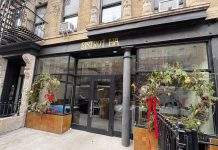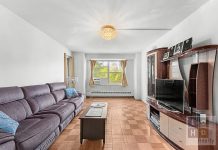
Almost five years after they went public with a headline-grabbing plan to create the world’s first underground park in an abandoned trolley station on the Lower East Side, founders of the Lowline have cleared a major hurdle. As we first reported Wednesday night, city officials have given their conditional approval for the ambitious project.
Representatives of the Economic Development Corp. (EDC) announced the decision at a meeting of Community Board 3. The Lowline responded to a Request for Expressions of Interest (RFEI) put out by the city late last year for the old Williamsburg Bridge Trolley Terminal. No other applications were received. In the next year, the Lowline is required to raise $10 million, submit schematic plans for the 60,000 square foot space and, as a press release put it, “implement a robust community engagement plan.”
In an interview, Lowline Executive Director Dan Barasch said, “It was an extraordinary day for us. It feels wonderful that the city is an enthusiastic supporter of the project. We’ve enjoyed extraordinary support across the community. Now we have a real vote of confidence from the city.”
Alica Glen, deputy mayor for housing and economic development, said in a statement, “The Lowline represents an incredible fusion of technology and public space. For eighty years, this underground space has sat idle. Now we’re putting it to use for the people of the Lower East Side and for all New Yorkers to enjoy. We can’t wait to see this experiment unfold.”
Charlie Gans, an executive vice president, took the lead for the EDC at the community board, describing the Lowline as an innovative public gathering and cultural space. “We have decided to conditionally designate the Lowline,” said Gans. Over the next year, he explained, there will be quarterly meetings of a new Community Engagement Committee and 5-10 public design charrettes. The historic trolley space, inactive since 1948, is owned by the City of New York and leased to the MTA. If the Lowline organization meets the agreed upon commitments, Gans said, “the acquisition process” will begin next fall. Shovels could be in the ground by late 2018.

Back in November, members of CB3 complained to the Economic Development Corp. about the lack of local consultation before the city officially issued the RFEI. As a result, officials extended the deadline for applications by a month. At the time, they said the community board would not have a role in the selection process, but that there would be many opportunities for feedback from local residents. On Wednesday evening, Gans called the city’s decision just “the first step in a long process” and said, “We’re going to be making sure that the Lowline is engaging with the community in a real way. That’s why this designation is conditional.”
For some community board members, these assurances fell far short of their expectations. Damaris Reyes, executive director of the housing advocacy organization, GOLES, is an outspoken critic of both the city’s handling of the former trolley space as well as of the Lowline proposal itself. Referring to last winter’s discussions between CB3 and the Economic Development Corp., she said Wednesday evening, “I feel so dissatisfied and so disappointed that you did not respect this community board enough to come to us the right way.”
Realistically, she argued, no developer could have pulled together a compelling proposal in the short amount of time between the publication of the RFEI and the submission deadline. “The Lowline,” she said, “has had an unfair advantage of working on this and putting together all the details, the renderings, for several years now.” Reyes added, “I just want to say that I’m really disappointed in the way that EDC is now coming here to tell us there was one applicant, that they’re designating the Lowline as the applicant, not recognizing that perhaps you need to go back to the drawing board and rethink this, because there could be a million and one uses for that space, and that you disregarded what we said, the challenges that we are facing in our community.”
In 2012, Community Board 3 voted 44-0 in support of the Lowline project. Many board members continue to be enthusiastic backers of the underground park vision. Others have their doubts, including MyPhuong Chung, chairperson of the land use committee. While acknowledging the city’s efforts to give applicants an additional month to submit proposals, Chung told city officials, “we didn’t have any input in the decisions that were made,” and noted that gentrification has only become a bigger issue on the Lower East Side since the board endorsed the Lowline four-years ago. Referring to pressures on the community, she said, “these are real issues and, moving forward, we need to address them. Please know that we’re serious about this.”
Other land use committee members questioned whether the Lowline would be a drain on public funds that could be used for other purposes, whether the space would be frequently closed to the public for private events and whether, as public member Harriet Cohen put it, would be overtaken by “hot dog stands and concerts.”

Committee member Dominic Berg was board chairperson when the Lowline went public in 2011. He was supportive of the project then, and continues to believe in it to this day. He suggested that other developers interested in the space could have started to work on ideas years ago. “This is a project that has been very, very well publicized for a long time,” said Berg. “The Lowline has been methodically working with the community… reaching out to all of the community leaders, trying to make sure that they are listening to the community and clearly trying to do what’s right for the community.”
Another longtime supporter, Councilmember Maragret Chin, urged people concerned about the project to become involved. She sponsored the first meeting of the Community Engagement Committee last month, along with Daisy Paez, tenant president of the Grand Street Guild apartments. She called the Lowline’s use of sunlight channeling technology for the park and the organization’s youth programming “amazing.” Chin told board members, “We can all have input… It’s really what we make of it. So I really encourage all of you to work with us and to work with EDC.”

When it was finally his turn to talk, the Lowline’s Dan Barasch said, “Our approach has always been, very consistently, that we simply want to take the space and turn it into a beautiful public gathering space that is used for the entire community, designed in close partnership with the community.” He encouraged anyone who’s interested to take part in the next community engagement meeting (it’s happening July 25.) Barasch said the committee, “will talk about real things — hours of operation, whether or not there’s retail, whether or not there’s programming happening in the space.” None of these things, he said, are “etched in stone.”
EDC officials have said they felt some urgency to develop the underground space now in order to capitalize on Essex Crossing, the large-scale residential and retail project now under construction in the immediate area. The developers are bullish on the Lowline, which they believe will draw locals and tourists alike to Essex Crossing’s shops, restaurants and entertainment venues. During this week’s meeting, Tim Laughlin of the Lower East Side Partnership said he’s convinced the subterranean park will also provide a boost to the neighborhood’s existing independent businesses. “I have long thought that the Lowline, as a project, would be a driver for small merchants,” said Laughlin. He cited the Lowline Lab, a prototype that opened in the Essex Street Market last October. The weekend-only community space has attracted 70,000 visitors. A food festival held in February drew a large crowd and led to big sales increases for Essex market vendors, Laughlin said.
There were, however, differences of opinion about the Lowline’s potential positive impact on local businesses. Cathy Dang, executive director of the advocacy organization, CAAAV, said she watched a longtime diner on Hester Street struggle after the opening of an art gallery. While the owner was, at first, optimistic about the arrival of a new clientele, he now believes the changes in the area have actually cost him business. Dang said she’s concerned the Lowline will have a similar impact. Laughlin countered that Essex Crossing and the Lowline together will, “drive foot traffic” and “support cultural institutions, support small businesses — both ones that have been here for multiple generations and ones that are new.”
At one point Wednesday night, Damaris Reyes asked Barasch whether his organization had released a community impact study conducted by the Hester Street Collaborative for the Lowline in 2015. The exchange offered a glimpse of the contentious history between certain community activists and the Lowline team over the last few years. During the meeting, Barasch acknowledged that the study had not been published. Reyes contended that opinions of Lowline detractors, such as herself, were initially discounted during the research phase of the project. Barasch said this assertion is untrue.
[This past March, The Lo-Down interviewed Barasch, Reyes, Hester Street Collaborative’s executive director and others about the research study. The initiative, paid for by the J.M. Kaplan Fund, was envisioned as a collaboration with GOLES, CAAAV and the Two Bridges Neighborhood Council. These groups initially agreed to participate in surveying their constituencies. Leaders of all three organizations told us they ultimately decided against taking part due to insufficient funding for robust outreach efforts. Members of the groups did participate in interviews conducted as part of Hester Street Collaborative’s survey. We’ll have more about this community engagement exercise in a future story.]
In the next several months, members of Community Board 3 will be seeking assurances from the Lowline team and from the city that the underground space will, in fact, operate for the benefit of the local community. City officials acknowledged that the former trolley space will eventually go through the city’s land use approval process (ULURP). Hearings before the community board and City Planning Commission will be required, the Borough president will weigh in and the City Council must vote on the final land disposition.









